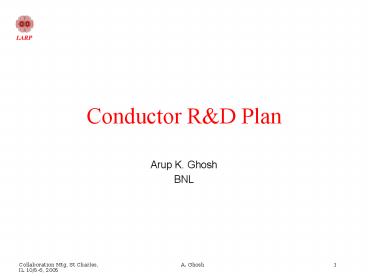Conductor R PowerPoint PPT Presentation
Title: Conductor R
1
Conductor RD Plan
- Arup K. Ghosh
- BNL
2
Introduction
- The first TQ magnets, TQC01 and TQS01 and SQ-02
use - 0.7mm Modified Jelly-Roll strands borrowed from
FNALs inventory - 27-strand cable with 1.0 Deg keystone angle
- Strand is of the 54/61 design with large
effective filament diameter 70-80 mm - Using Nominal heat treatment ?Jc gt 2000 A/mm2
but the strand has a low stability current Is - We now understand that Is in unstable strands is
strongly influenced by dynamic effects - Improve thermal environment ??Increase RRR of
stabilizing copper - Achieve this by preventing excessive reaction of
Nb-barrier - Optimize Reaction Time/Temp to increase the
stability current to be well above magnet
operating current
3
Heat-Treat Optimization
Jc(12T-15T)
HT-Temp 635C-695C Time
Strand Stability for large Deff
Higher Bc2 at higher T
RRR
Bc2
4
Ic and Is of virgin and of Strands Extracted
from LARP Proto-type Cables
5
Commercial sources of high Jc Nb3Sn
- With the exception of ShapeMetal Innovation,
Netherlands, (SMI), which uses Powder-in-tube
technology (PIT) and has delivered strand to
FNAL in the past, there is only one reliable
source of high-Jc strand in the US. - Oxford Superconducting Technology (OST)
- MJR Conductor has been phased out
- Present technique is RRP (Rod-Restack Process)
- Uses a distributed barrier approach
- Jc (12T) 3000 A/mm2
- Effective Filament Diameter Deff Sub-element
Diameter - Deff scales inversely with increasing number of
Sub-elements
6
RRP strand
- Long-lead item 6-9 months after placing order
- SC vendor planning 12-13 months
- Under the direction of the Conductor Development
Program, OST has developed strands with
increasing number of sub-elements to reduce Deff
Billet 7054 54/61
Billet 7904 126/127
Billet 8079 90/91
7
RRP Strand for LARP
- OST has the most experience in fabricating
strands of 54/61-stack design. This is considered
a production wire used in the NMR business - Very limited experience with the 91 or the 127
stack design. These billets are presently
considered by OST to be RD billets. - For FY06 LARP would like to use strands with the
84/91-stack design - Why? Why not use the production 54/61 strand ?
- Stability will improve with decreasing
sub-element diameter - Question is how to move from RD to production
at OST
8
Nb3Sn Strand Specification84/91 Design
9
Nb3Sn Strand Specification54/61 Design
10
Conductor Development Program
- CDP has been the main driver in OSTs high-Jc
strand RD. - It continues to fund this development in FY06
- Main Goals ?reduce Deff, billet scale-up,
(NbTi)3Sn - LARP can take advantage of the strand that is in
the CDP inventory to conduct strand
characterization for use in TQ-type cable - LARP can also borrow from the CDP inventory
- At present OST is fabricating strand for CDP that
is similar to strand being considered for LARP
purchase
11
CDP-RD Inventory
Compiled with D.R Dietderich
Yield of billet 8502 is 50 due to wire
breakage Billet 8521 is in process, yield not
known
12
Comments
- 30 kg can be fabricated into 5 ULs each 65m
long. Each UL is for a TQ-coil - With the exception of billet 8079, all the strand
in CDP inventory is the high Sn-content capable
of a Jc of 3000 A/mm2. The most recent billet
8220 (54/61-design) has this Jc and a RRR 200.
With this RRR the stability current is
1000-1100 A. - Most of the RRP strand at 0.7mm have yet to be
cabled as a TQ-cable with 1.0 deg keystone. LBL
has recently made a short (17m) trial piece of
27-strand TQ cable using strand from 8220. This
is being evaluated for Ic, Is and RRR. - A short length 4m of cable has also been
fabricated using strand from 8079 (90/91-design),
this too is under evaluation. Strands from this
billet show stability currents gt 1200A. - For strands with either the 61, 91 or 127 stack,
the key parameter that ensures a high stability
current is the RRR of the copper stabilizer. - Provided the copper remains clean, strand
stability increases as the stack number is
increased i.e. sub-element size is decreased
13
Recent OST Billets
14
Target Program
15
Total Conductor Estimate
Total
Total 936 kg Plan for 1100 kg
16
Procurement Plan
Low Risk
Low-Risk
Higher Risk
17
Procurement Strategy
- CDP has two billets on order which uses the same
sub-element with the potential for Jc(12T) 3000
A/mm2 - One uses 54/61 design
- The other 84/91 design
- Delivery 11/31/05
- CDP is also placing an order for 90 kg for high
Jc wire using the 84/91 design Delivery 3/31/06 - LARP will place an initial order for 95 kg (this
is the yield from one sub-element extrusion
billet) - 54/61 design Delivery 3/31/06
This allows for material to be in the pipeline
that we are certain to have in hand for the
magnets being fabricated in FY06. If the 84/91
billets for CDP are successful then LARP could
swap that with the 54/61 wire delivered under
its order
18
Summary
- Present Status
- Draft specification sent to OST
- Wire from Billet 8502 (84/91) arriving LBL
10/10/30 - This wire needs to be characterized for Ic, Is
and RRR - Cable using billet 8220 (54/61) under
investigation - LARP order needs to be placed soon

